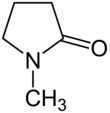N-Methyl-2-pyrrolidone
 | |
 | |
| Names | |
|---|---|
| IUPAC name
1-Methyl-2-pyrrolidone | |
| Other names
N-Methylpyrrolidone; N-Methylpyrrolidinone; NMP; 1-Methyl-2-pyrrolidone; Pharmasolve | |
| Identifiers | |
| 872-50-4 | |
| ChEBI | CHEBI:7307 |
| ChEMBL | ChEMBL12543 |
| ChemSpider | 12814 |
| |
| Jmol-3D images | Image |
| KEGG | C11118 |
| PubChem | 13387 |
| |
| UNII | JR9CE63FPM |
| Properties | |
| Molecular formula |
C5H9NO |
| Molar mass | 99.13 g·mol−1 |
| Density | 1.028 g/cm3 |
| Melting point | −24 °C (−11 °F; 249 K) |
| Boiling point | 202 °C (396 °F; 475 K) |
| Hazards | |
| NFPA 704 | |
| Except where noted otherwise, data is given for materials in their standard state (at 25 °C (77 °F), 100 kPa) | |
| | |
| Infobox references | |
N-Methyl-2-pyrrolidone (NMP) is an organic compound consisting of a 5-membered lactam. It is a colorless liquid, although impure samples can appear yellow. It is miscible with water and with most common organic solvents. It also belongs to the class of dipolar aprotic solvents such as dimethylformamide and dimethyl sulfoxide. It is used in the petrochemical and plastics industries as a solvent, exploiting its nonvolatility and ability to dissolve diverse materials.[1]
Preparation
NMP is produced industrially by a typical ester-to-amide conversion, by treating butyrolactone with methylamine. Alternative routes include the partial hydrogenation of N-methylsuccinimide and the reaction of acrylonitrile with methylamine followed by hydrolysis. About 20,000 to 30,000 tons are produced annually.[1]
Applications
NMP is used to recover certain hydrocarbons generated in the processing petrochemicals, such as the recovery of 1,3-butadiene and acetylene. It is used to absorb hydrogen sulfide from sour gas and hydrodesulfurization facilities. Due to its good solvency properties NMP is used to dissolve a wide range of polymers. It also used as a solvent for surface treatment of textiles, resins, and metal coated plastics or as a paint stripper. It is utilized as a solvent in the commercial preparation of polyphenylene sulfide. In the pharmaceutical industry, N-methyl-2-pyrrolidone is used in the formulation for drugs by both oral and transdermal delivery routes.[2]
Biological aspects
NMP is on the list of Chemicals Known to the State to Cause Cancer or Preproductive Toxicity cited in California Proposition 65 (1986).[3][1] In the face of increasing regulation, some manufacturers are considering alternative solvents for some applications, especially where worker exposure is difficult to control, such as in paint stripping, graffiti removal, and agriculture.[4]
On the other hand, NMP biodegrades readily and has low toxicity to aquatic life.[1]
See also
References
- ↑ 1.0 1.1 1.2 1.3 Albrecht Ludwig Harreus, R. Backes, J.-O. Eichler, R. Feuerhake, C. Jäkel, U. Mahn, R. Pinkos, R. Vogelsang"2-Pyrrolidone" in Ullmann's Encyclopedia of Industrial Chemistry, Wiley-VCH, 2011, Weinheim. doi:10.1002/14356007.a22_457.pub2
- ↑ "Pharmasolve® Drug Solubilizer" (PDF). PharmaGuide (International Specialty Products, a division of Ashland Inc.): Page 9. Retrieved 2012-06-06.
- ↑ "List of Chemicals as Known to the State of California to Cause Cancer or Reproductive Toxicity" (PDF). California OEHHA. Retrieved 4 December 2012.
- ↑ Reisch, Mark (July 21, 2008). "Solvent users look to replace NMP". Chemical & Engineering News: 32.
